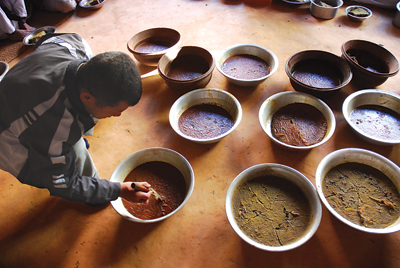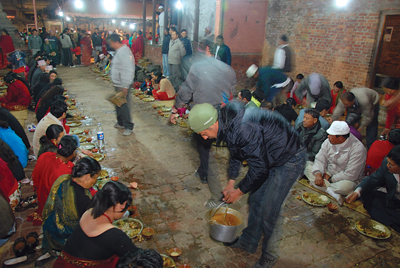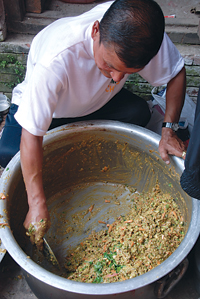December 2010
http://ecs.com.np/feature_detail.php?f_id=429

 THE LAPTE BHOJ
THE LAPTE BHOJ
A traditional Newari feast is known as lapte bhoj. This terminology deserves attention in today´s times because although many feasts now are planned for convenience and arranged as buffets, some Newari families prefer to have it in the customary way. So, to better prepare the guests, the hosts make it a point to mention that they will be hosting a lapte bhoj, in which case, the guest has to understand that he/she will have to come more comfortably dressed (which is essential since you have to sit cross legged for a long time), and must be prepared to give more time (as he/she will not be able to get up until the eldest, and most probably, slowest eating guest, has risen, following, as it is, an elaborate and time consuming feast).


Recipe for a typical Newari delicacy
How To Make Swanpuka (lungs filled and fried)
Ingredients
http://ecs.com.np/feature_detail.php?f_id=429
Without
being disparaging, allow me to quote an old Nepali saying - Brahmins are
spoiled due to indulgence, and Newars, due to too much of feasting. How
far it is true is not for this writer to judge, but as far as the
Newars are concerned, it is a fact that they are still said to look for
the slightest excuse to have a feast (bhoj). The Newars are a very
sociable lot, more so within their own ethnic social structure. In
addition, due to inter marriage within their own small ethnic
population, Newars have large families, for every marriage means an
addition of more relatives. Therefore, even the smallest of feasts in a
Newar family could mean anywhere between 50 to 60 invitees.

And, there are quite many such feasts throughout
any given year, the exception being when a family has been bereaved in a
particular year. In such a case, the bereaved family and its closest
relatives stay aloof from any sort of festivities for a year´s time.
However, every year in Bhadra (August end or thereabouts), all those who
have suffered a loss in the preceding year participate in a unique
festival called, Gai Jatra. The smaller kids of a bereaved family,
dressed in funny costumes, take part in a carnival like procession
consisting of many other participants from other similarly afflicted
families. This festival signals the beginning of the festive season.
Many more festivals follow in quick succession till Baisakh (mid April),
the start of one more Nepali New Year. It should be mentioned here that
Newars have their own New Year, which is on the day of ´Mha Puja´, a
day before ´Bhai Tika´ during the Tihar festival. Anyway, feasting
starts from Gai Jatra itself and, for Newars, continues throughout the
year during each and every Newari festival. Events, like birth,
marriage, Bartaman (a kind of baptism of boys to the Hindu faith), Gufa
and Bel Bihwa (coming of age ceremony for girls), and so on are also
occasions that call for feasts.

A traditional Newari feast is known as lapte bhoj. This terminology deserves attention in today´s times because although many feasts now are planned for convenience and arranged as buffets, some Newari families prefer to have it in the customary way. So, to better prepare the guests, the hosts make it a point to mention that they will be hosting a lapte bhoj, in which case, the guest has to understand that he/she will have to come more comfortably dressed (which is essential since you have to sit cross legged for a long time), and must be prepared to give more time (as he/she will not be able to get up until the eldest, and most probably, slowest eating guest, has risen, following, as it is, an elaborate and time consuming feast).
Before entering the room for the feast, the
guests take off their shoes. There is a lot of joking and jesting as the
guests settle down comfortably on the long, narrow sukuls (straw mats
that can be rolled up). A lapte (literally meaning leaf plate) made from
leaves of the Sal tree, is placed before each guest along with a pala
(small clay bowl). At regular intervals along the rows are kept brass
karuwas (snout nosed vessels containing drinking water). The service
starts from the eldest guest. First, two hand fulls of baji (beaten
rice) are served. In Nepal there are different types of baji, the ones
served in Newari feasts are the tastier types (those made in Kathmandu),
which are whiter, larger and flatter than the others. The usual curries
served are, gainda gudi (made of different lentils), hariyo saag (green
spinach) and alu tama (potatoes and bamboo shoot curry). Achaar
(pickles), which can be of two kinds, are served next. Alu kerau (a
spicy concoction of potatoes, green peas, small brown peas and radish)
and tamatar ko achaar (made of ripe tomatoes) are the most popular. It
must be mentioned that the achars can be really spicy and hot to the
uninitiated.
Then comes the dish everyone is waiting
expectantly for, the meat curry. Either mutton or buff (buffalo meat),
with lots of gravy, is served (traditionally, Newari feasts serve buff,
but in recent times, mutton is noticed to be more preferred). This, the
serving of meat, is a time consuming affair, since, at every stop, the
server has to make sure that meat pieces are served according to choice.
And different guests have different choices, obviously. Some take quite
a while finalizing their choice pieces which only goes to prove the
fact that the Newars are connoisseurs of meat. As soon as it is served,
the guests start eating.

THE ´BHOJ´ IS ON!
As they eat, all the while bantering with each other, more dishes continue to be served and these are the tasty morsels of different varieties of meat. A Newari bhoj has from half a dozen to a dozen types of such delicious morsels. Hakuchoila (grounded meat broiled and spiced up), bhuttan (deep fried intestine and other stomach parts), senla mu (steamed and sautéed liver), swanpuka (lungs filled and fried – see recipe below) and mainh (fried pieces of tongue) are particularly delicious, as are other edible parts of the head, whether of a buffalo or a goat. It is customary to serve various head parts according to guest seniority. Therefore, the right eye, cooked well, is served to the eldest, the left eye to the next oldest, and so on.
As they eat, all the while bantering with each other, more dishes continue to be served and these are the tasty morsels of different varieties of meat. A Newari bhoj has from half a dozen to a dozen types of such delicious morsels. Hakuchoila (grounded meat broiled and spiced up), bhuttan (deep fried intestine and other stomach parts), senla mu (steamed and sautéed liver), swanpuka (lungs filled and fried – see recipe below) and mainh (fried pieces of tongue) are particularly delicious, as are other edible parts of the head, whether of a buffalo or a goat. It is customary to serve various head parts according to guest seniority. Therefore, the right eye, cooked well, is served to the eldest, the left eye to the next oldest, and so on.
While these tit bits are being offered, somebody
will be busy pouring aila (homemade fiery liquor made from barley or
rice) into the palas. The serving of the aila is an art in itself. The
fiery liquor is poured by an expert hand (often, female), from an
equally special container, the anti, a brass vessel with a long narrow
snout. The aila is poured from quite a height and the liquor flows in a
long graceful gush into the small palas without overflowing. Often, the
standard of a feast is judged by the quality of the liquor served. The
best aila bursts into a bluish flame at the touch of a spark. Raw
carrot, radish, cucumber, onion and tomato slices with soaked peas come
next. This is known as chuse muse and is a salad of sorts.

It is to be expected that the general mood
becomes much more jovial after the first palas have been downed.
Appetites also become heartier, and second servings are generous. Now
the aila server is the busiest person around, and the mood of the feast
is, yes, very festive. As can be imagined, a Newari bhoj, particularly
the lapte bhoj, is not one to be taken lightly. A lot of preparation
goes into the making of one and the proper conduct of a Newari bhoj is a
backbreaking affair, as service will have to be continuous and
efficient. Therefore, if invited to one, guests shouldn´t mind if they
have to give a lot of their time. No doubt it will be highly enjoyable,
to say the least.
Signaling the final stages of the bhoj, small
leaf bowls with sweet and sour lapsi paun is served. This is actually
the dish that will help in the digestion of all the rich food consumed
during the magnificent bhoj. It is made of sour lapsi which is said to
have very important medicinal properties, particularly concerning
indigestion and flatulence. Finally, a hand full of baji is served once
more. Curd and sugar come next. The curd specially is an important part
of a Newari bhoj, the Newars being particularly well known for making
delicious curds as can be confirmed by tasting Bhaktapur curd (known as
juju dhau). Jeri, and often, rasbhari (two kinds of sweet meats), are
also served simultaneously. These constitute the dessert.
After everybody has finished, three servers go
around to each guest, one holding an empty bata (a large, circular and
shallow vessel); one holding a karuwa of water and the third, a towel.
Each guest washes his hands in the bata while water is being poured from
the karuwa. The end of the feast (maybe to the relief of those feeling
cramps at having to sit cross legged for a long time), is confirmed by
the eldest guest rising up from his seat. The others follow suit
dutifully. It can be said that the Newar bhoj is no ordinary feast. It
is quite scientific in nature. The food is well balanced. Liquor keeps
the appetite going, thus making the host happy at his elaborately
prepared feast being appreciated. Lapsi paun makes sure no one suffers
after-feast pains, and of course, there is no washing up to be done as
the laptes and the palas are entirely disposable!
How To Make Swanpuka (lungs filled and fried)
Ingredients
- 1 pair of lungs of lamb
- 1 tsp turmeric powder
- 3 cups gram flour
- 1 tsp cumin powder
- 2 tsp salt
- 3 cups water
- 1 tsp red chili powder
- 2 eggs
- 1 tsp fresh ground ginger
- 3 tbsp oil (for mixture)
- 1 tsp fresh ground garlic
- Oil for frying
Check that the lungs are fresh and confirm that it is not punctured, by
blowing into it. Clean the lungs, and put into it one tablespoonful of
oil, patting it all over while doing so. Then turn it upside down to
make sure that all the remaining blood and gas is expelled.
The filling
Voila! Swanpuka, one of the exotic dishes of the Newars is ready for your eating pleasure.
The filling
- Mix all the ingredients (except eggs), and to this, add water gradually until you have a smooth mixture. Now beat the eggs into the mixture. Pour this mixture into the lungs very slowly. Press down firmly with your fingers as the lungs fill up to the trachea. In this way, pour in all of the mixture. Now blow into the lungs a couple of times. You will know that it is fully filled when it stands hard and there is a lightening of color. Add more mixture as needed.
- Next, fold the top of the trachea and tie it up with a string so that the mixture does not flow out.
- Boil the filled lungs. Cut into small pieces (about 2 inches square and ½ inch thick). Heat oil in a pan. Fry the small pieces of filled lungs until well done.
Voila! Swanpuka, one of the exotic dishes of the Newars is ready for your eating pleasure.
No comments:
Post a Comment